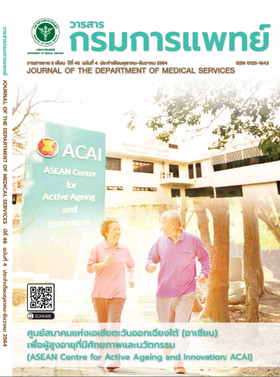Retrospective Comparison Study of Non-operative Treatment between Saline Hydrostatic Reduction under Ultrasonographic Guidance and Pneumatic Reduction under Fluoroscopic Guidance in Intussusception Patients at Queen Sirikit National Institute of Child He
Keywords:
Intussusception, Hydrostatic reduction under sonographic guidance, Pneumatic reduction under fluoroscopic guidanceAbstract
Background: Intussusception is a common cause of bowel obstruction in emergency setting of pediatric age. Prompt diagnosis and treatment are necessary. This condition is treatable by non-operative radiological method. Objective: To compare the results of non-operative treatment between saline hydrostatic reduction under ultrasonographic guidance and pneumatic reduction under fluoroscopic guidance in intussusception patients at Queen Sirikit National Institute of Child Health (QSNICH). Method: A retrospective cohort study to compare the success rate of treatment between saline hydrostatic reduction under ultrasonographic guidance and pneumatic reduction under fluoroscopic guidance in intussusception patients at QSNICH were collected between October 2017 and February 2019. Results: Fifty-three non-operative reduction of intussusception from 49 patients (age ranging from 2 months to 4 years 1 month) were enrolled. Thirteen from nineteen intussusceptions (68.4%) were successfully reduced by saline hydrostatic reduction under ultrasonographic guidance without perforation or recurrence. Thirty from thirty four intussusceptions (88.2%) were successfully reduced by pneumatic reduction under fluoroscopic guidance. Two patients had bowel perforation under the pneumatic reduction (perforation rate 5.9%). Five patients who treated by pneumatic method had the second episode of recurrence after the first intussusception at an interval of 2 days to 4 months (recurrent rate 14.7%). One patient underwent both hydrostatic method and pneumatic method consecutively with a failure from both methods. Conclusions: The success rate of hydrostatic method was not significant statistically difference from pneumatic method (p = 0.077).
References
Coley BD. Caffey’s Pediatric Diaggnostic Imaging.13th ed. Philadelphia: Elsevier; 2019.
Talabi AO, Famurewa OC, Bamigbola KT, Sowande OA, Afolabi BI, Adejuyigbe O. Sonographic guided hydrostatic saline enema reduction of childhood intussusception: a prospective study. BMC Emerg Med 2018; 18:1-7.
Avci V, Agengin K, Bilici S. Ultrasound Guided Reduction of Intussusception with Saline and Evaluating the Factors Affecting the Success of the Procedure. Iranian Journal of Pediatrics 2018; 28:e62442.
Khorana J, Singhavejsakul J, Ukarapol N, Laohapensane M, Wakhandrittee J, Patumanond J. Enema reduction of intussusception: the success rate of hydrostatic and pneumatic reduction. Ther Clin Risk Manag 2015;11:1837-42.
Srisarakham P, Nueaitone K, Sankote W, Hangsanankul N, Jaroensuk SP, Sujritkul J, et al. New era in intussusception reduction under ultrasound guidance by pneumatic and hydrostatic technique, Ten years experience in Mahasarakham Hospital, North Eastern, Thailand [Internet] 2019. [cited
Mar 30]. Available from: www.rcrt.or.th/rcrt-rst-2019-download/download/RCRT-RST_2019_E-BOOK.pdf.
Wattanaruangkowit P. Hydrostatic Reduction of Intussusception under Ultrasound Guidance: Report of 8 cases and Review of Literatures. Thammasat Medical Journal 2001; 1: 1-10.
Mahayosnond A, Sethsakul E, Trinavarat P, Chomdej S, Roekwibunsi S. Treatment of pediatric intussusception by pneumatic reduction under ultrasound guidance: first case of King Chulalongkorn Memmorial Hospital. Chula Med J 2004; 48:299-307.
Ito Y, Kusakawa I, Murata Y, Ukiyama E, Kawase H, Kamagata S, et al. Japanese guidelines for the management of intussusception in children, 2011. Pediatr Int 2012; 54: 948-58.
Sompun K, Aunchalee K. Development of the treatment of Intussusception in children by the wind to enema in Queen Sirikit National Institute of Child Health since 1992 – 2009, Sarnraksarnfun Journal 2553;2:9.
Khong PL, Peh WC, Lam CH, Chan KL, Cheng W, Lam WW, et al. Ultrasound-guided hydrostatic reduction of childhood intussusception: technique and demonstration. Radiographics 2000; 20:E1.
Downloads
Published
How to Cite
Issue
Section
License

This work is licensed under a Creative Commons Attribution-NonCommercial-NoDerivatives 4.0 International License.
บทความที่ได้รับการตีพิมพ์เป็นลิขสิทธิ์ของกรมการแพทย์ กระทรวงสาธารณสุข
ข้อความและข้อคิดเห็นต่างๆ เป็นของผู้เขียนบทความ ไม่ใช่ความเห็นของกองบรรณาธิการหรือของวารสารกรมการแพทย์


